US-Made Dassai Blue Nigori Sparkling Sake Integrates Domestic Ingredients With Japanese Tradition
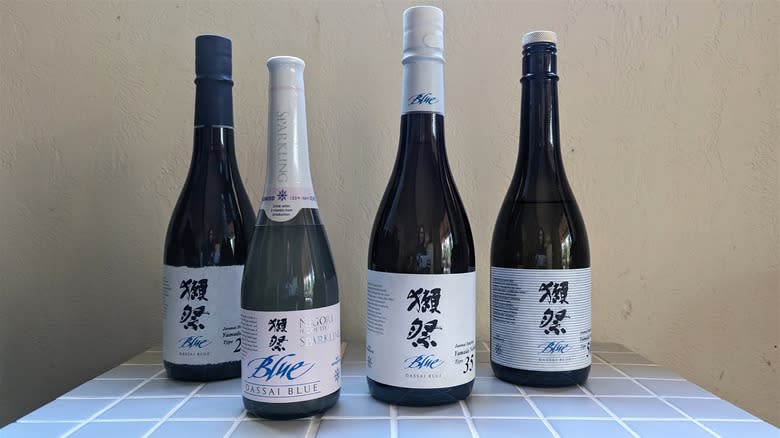
Sake is too often overlooked by many in the U.S. in favor of beer or wine, but that is changing, especially with craft sake production popping up closer than ever before. The Japanese sake brewery, Dassai, located in the Yamaguchi Prefecture in Japan, opened a craft brewery in Hyde Park, New York in September 2023, bringing the knowledge and precision of craft sake brewing to their U.S. iteration, Dassai Blue. With four unique sakes available, Dassai Blue is integrating domestically brewed sake into the market with ease. The premium Junmai sake has a reputation in Japan that has carried over to the U.S., using traditional techniques while working with domestically grown rice to produce craft sake.
Dassai Blue sent over their newest Nigori Sparkling sake and their Type 23, Type 35, and Type 50 for us to try. I also had the opportunity to talk with U.S. company president Kenzo Shimotori and brand manager Jocelyn Heyward to learn more about the brand and the New York sake production. Combining my sake education from the University of Gastronomic Sciences and my sensory training as a sommelier, I tasted and reviewed the complete line-up. If you're a sake enthusiast or looking to become one, you'll want to get to know this U.S. brewed sake.
Some recommendations are based on first-hand impressions of promotional materials and products provided by the manufacturer.
Read more: 13 Liquors Your Home Bar Should Have
New York-Based Dassai Blue Is A Family-Owned And Operated Business
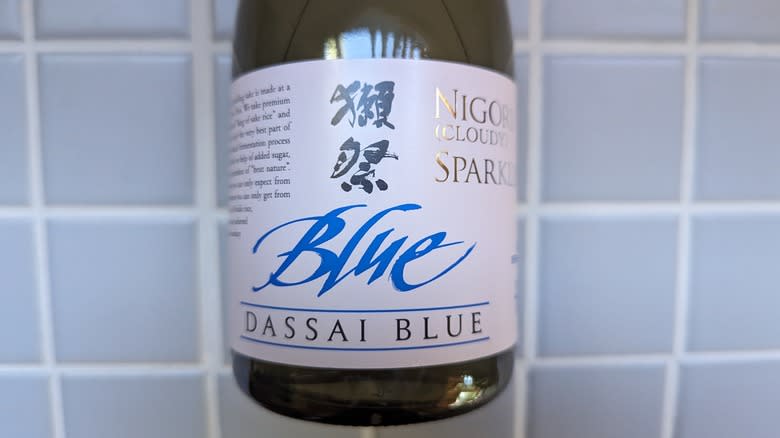
With multi-generational roots in Japanese sake production, the conception of Dassai Blue in New York has remained a family-owned and operated business. Hiroshi and Kazuhiro Sakurai are father and son and the third and fourth generations in charge of the New York brewery. Similar to Japanese sake, all sake from Dassai Blue is Junmai Daiginjo, a tier of sake made with rice that has been polished down to 50% or less, pulling out more delicate and distinctive notes in the final product. The number in the Type 50, Type 35, and Type 23 refers to the rice polishing ratio.
The company revamped an old grocery store into a sophisticated-looking brewery and tasting room, which opened for tours and tastings in the fall of 2023. Keeping association with the original brand, the Sakurai's kept the "Dassai" and added the "Blue" as a distinction between what is brewed abroad versus domestically. The name comes from a Japanese proverb that says, "Although blue dye comes from the indigo plant, it is bluer than indigo."
With a team of four Japanese brewers and six American brewers, Dassai Blue is making the Junmai Daiginjo sake with Yamada Nishiki rice, the top standard variety for sake production. They work with Isbell Farms in central Arkansas, a family-run farm specializing in sustainably grown sake rice. The sake production has remained small, with many of the processes being done by hand, including washing the rice and making the koji.
What Is Dassai Blue Nigori Sparkling Sake?
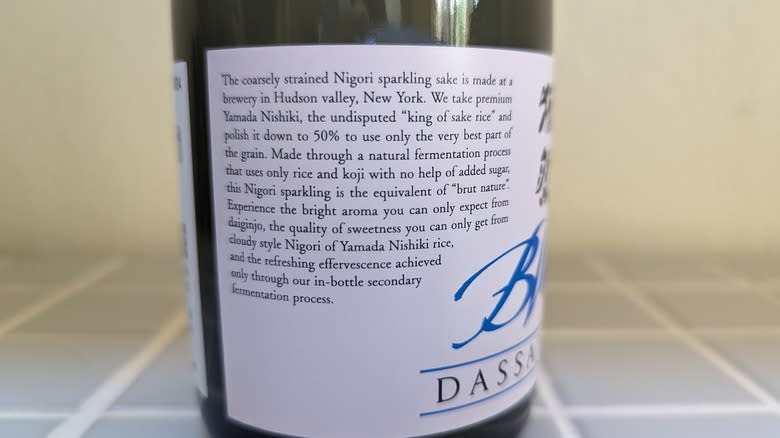
Dassai Blues' fourth and latest sake is their Nigori Sparkling. The Nigori Sparkling is unique to the Dassai line-up and other sakes in a couple of different ways. The most obvious one is that it's sparkling instead of still. There are a few ways to arrive at a sparkling beverage of any kind. The fastest and least intensive option is to simply inject the drink with carbon dioxide. This is only done for inexpensive production. Beverages can also undergo a mass secondary fermentation in a tank. This is one step up from CO2 injection and is typically done with low to mid-end sparkling drinks, like Prosecco. Finally, the most artisanal and craft sparkling process is through secondary fermentation directly in the bottle. This is how Champagne is made, and is by far the most labor-intensive. This artisanal, secondary bottle fermentation is how the Dassai Blue Nigori Sparkling gets its' bubbles.
The second unique trait of the Nigori Sparkling is that it is 'nama', or unpasteurized sake. This means the sake isn't nearly as shelf-stable as a pasteurized sake and should be enjoyed within about 40 days. The benefit of not pasteurizing is that it doesn't strip the sake of the inherent liveliness that comes from the fermentation, ultimately retaining some of the fresher and brighter characteristics of the drink. Even though some refer to sake as 'rice wine', that's really not quite right since wine references grapes being involved, and this is just rice.
How Is The Dassai Blue Nigori Sparkling Sake Made?
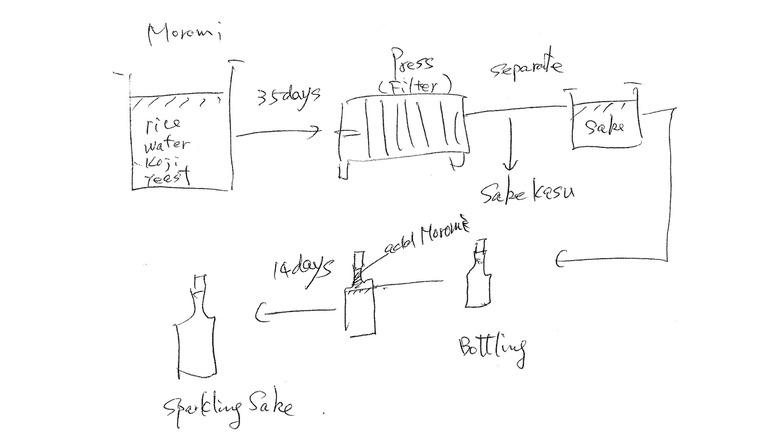
The Nigori Sparkling sake starts as the Dassai Blue 50, with the Yamada Nishiki rice polished down to 50%. At this point, when only half the rice kernel is left, it looks rounder and kind of pearly white. The rice is then hand-washed, rinsed, and soaked. Then, the rice is steamed in small baskets before being added to the moromi. The moromi consists of steamed rice, handmade koji, water, and carefully selected yeast. With the right consistency and temperatures, the first fermentation kicks off in covered tanks. The fermentation process takes 35 days for the yeast and koji to convert the glucose sugars into alcohol. In a happy fermentation, visible bubbles actively come to the surface, showing the active transformation.
The sake is then only coarsely filtered. A significant amount of rice solids don't get strained in this subtle filtration process, meaning the sake remains quite cloudy. It also changes the body of the sake. 'Nigori' refers to the cloudiness that results from the lack of fine filtering. This adds a lot of texture, mouthfeel, and an opaque, dirty white color, but in the best way! It's kind of like the equivalent of a natural wine; it just feels more alive because it is. The sake is then bottled with a small amount of moromi to kick off a second fermentation that lasts 14 days, producing additional CO2 that is trapped in the bottle, resulting in sparkling sake.
Where To Find Dassai Blue Sake
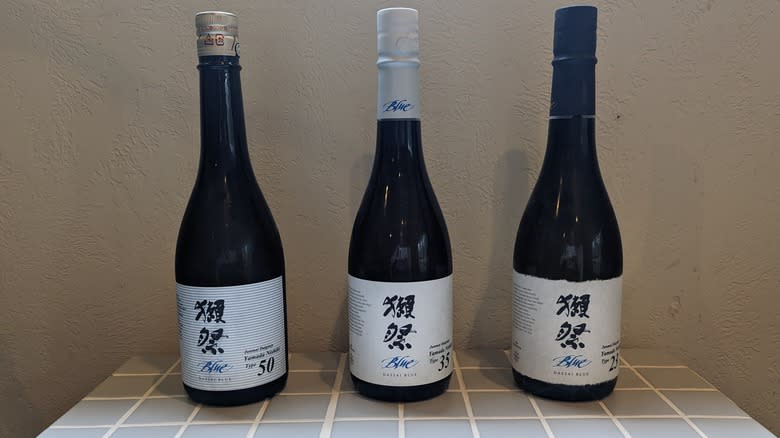
Looking to track down a bottle of Dassai Blue Nigori Sparkling sake or a still Dassai Blue of your own? If you are a New York state resident, you may actually find a bottle in person at a number of specialty shops. Of course, you can buy the sake directly from the Hyde Park brewery, where you can also book a tour and tasting. If you aren't in New York State, you can purchase the sake online at Union Square Wine & Spirits, Ambassador Wine & Spirits, or Rolling Barrel Wine & Liquor.
The Nigori Sparkling sake is $19 for 360ml. While the 720ml still Type 50 is $27, Type 35 is $50, and the most premium bottle from Dassai Blue, Type 23, is $79.99. For a mid-level craft sake, the prices are comparable to many other Junmai Daigingo sakes available on the domestic market. The Nigori compares in quality and price to another American-brewed nama sake by Brooklyn Kura. Overall, the whole Dassai Blue line-up compares quite favorably to other American brewed sakes, coming in at a bit higher quality with the price following suit.
How To Drink The Dassai Blue Sake
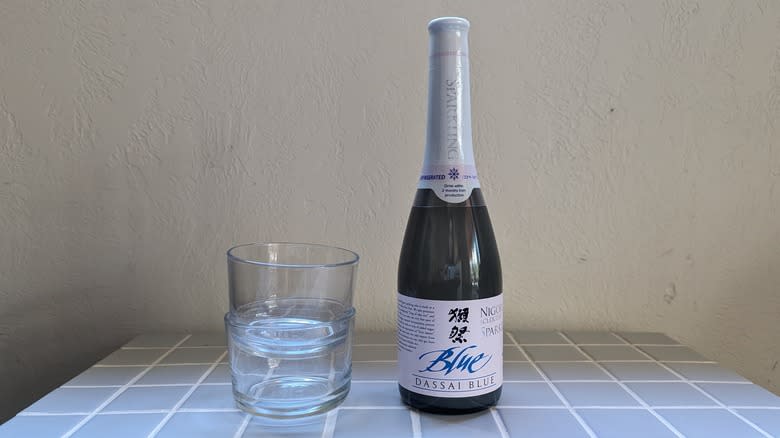
All the Dassai Blue sake should be stored and served cold. While the Type 23, Type 39, and Type 50 can be stored for up to three months, the sooner you consume them, the fresher the profile will be. After opening, the still sakes will last about 1-2 weeks, however, they will start to oxidize right away and the profile of the sake will deteriorate, becoming less aromatic and a bit flat.
In the case of the Nigori Sparkling, because it is a nama sake, it doesn't have the stability of the other pasteurized sakes. This means that, like the others, it should also be stored cold. The difference with the Nigori Sparkling sake is that it should be enjoyed in a much shorter time frame. Aim to drink this one within 40 days of the bottle date. Once opened, it should be consumed right away so it retains all the bright effervescence since it's a sparkling sake. If you have the bottles in the fridge for a while and are unsure if the sake is still good, open it up and see if it smells sour. If so, it may have gone bad.
Dassai Blue Nigori Sparkling Sake Taste Test
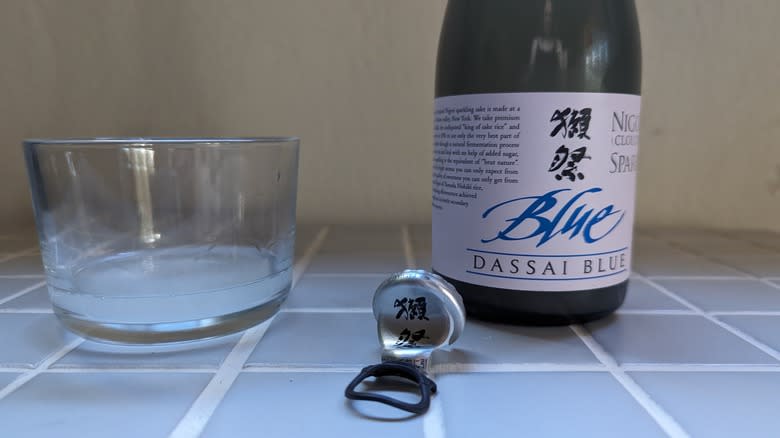
The Nigori Sparkling sake is a smaller bottle at 360 milliliters. The colored glass doesn't allow you to see the true cloudy nature of the sake until you pour it. The label has some great basic information, indicating that it's Yamada Nishiki rice polished to 50% and goes through an in-bottle secondary fermentation. The design is a good size for a sparkling sake, small enough to consume in one evening. The Champagne style wrapper comes off easily and the pull-back nature of the crown cap is quite satisfying and resealable.
The sake is slightly murky but not as opaque as some nigori sake. It has a misty appearance, with delicate bubbles rising to the surface. The bubbles aren't as aggressive as Champagne bubbles. They are small but a bit more delicate and slow. With aromas of green pear skin, green apple, white blossoms, and cream. It's a pretty aromatic nose overall with definitive floral elements that sing through. The body is also richer and fuller with a big texture from both the lack of fine filtering and the bubbles. The green fruit from the nose comes through on the palate too, with a star fruit and ripe apple flesh sweetness. Even though the sake is "dry," the residual rice and juicy fruit notes make it seem sweeter than it actually is. It does have a good level of acidity to balance this sensation. It's energetic, with a range of flavors across the palate.
What To Pair With Nigori Sparkling
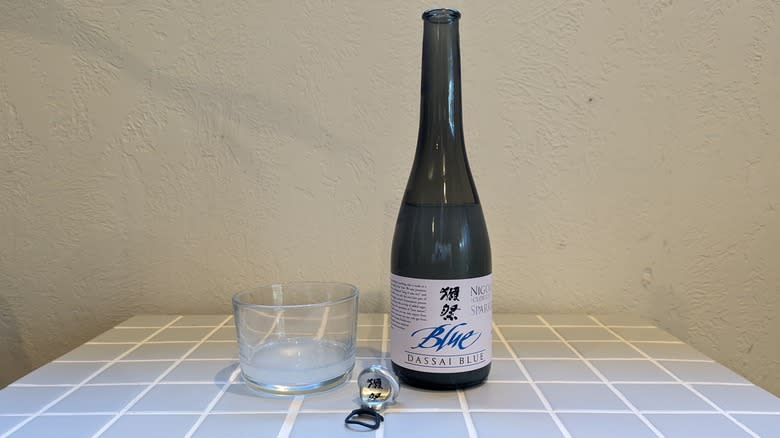
While this sake could be paired with spicy tofu, sesame broccoli, a ripe nectarine, or chocolate mousse, I would suggest this as a pre-dinner sip or a stand-alone dessert. The mouthfeel and sensation of sweetness from the fruit notes make this sake hold its own and have it drifting into dessert territory. That being said, the bubbles and fresh element of the sake are an inviting drink to start or end an evening with. If you are looking to match this sparkling number with some food, think about fruit-forward desserts, creamy cheeses, or other lactic foods that have both a textural component as well as a bit of that wild, fermented edge that brings things to life. Like a herby yogurt dip with baby radishes and carrots to start off the meal. The cloudy body of this wine really leans toward creamy foods that meet it halfway.
Dassai Blue Nigori Sparkling Sake Vs. Dassai Blue Type 50
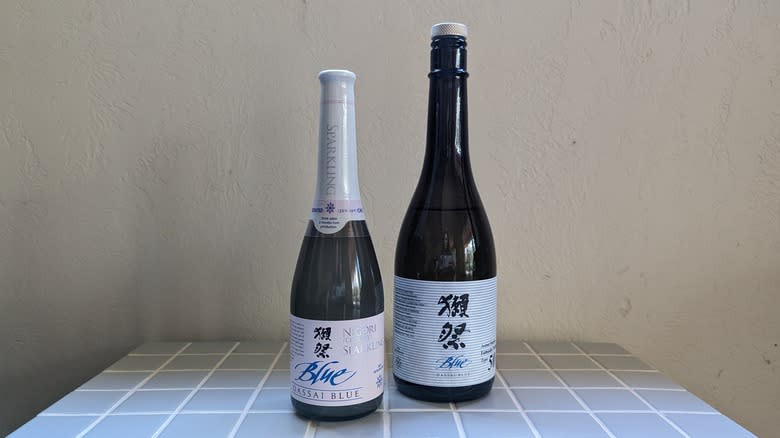
Comparing the Dassai Blue Nigori Sparkling sake with the Type 50 is interesting because although they're quite different, they start off as the same product. The Yamada Nishiki rice is polished down to half its original size and added to the moromi mash with koji, yeast, and water. After the 35-day fermentation, the Type 50 goes through a fine filtration process prior to bottling. The Nigori Sparkling sake, on the other hand, doesn't go through the same filtration or pasteurization process. It's then bottled with more moromi mash to start a secondary fermentation in the bottle, giving it bubbles.
Because they are both polished to 50%, they are both Junmai Daigingo sakes, but they have heavier mouthfeels than finer polished rice. The Type 50 expresses less aromatic and less sweet than its nigori nama counterpart. It does have a medium-light body with a punchy finish, though it doesn't linger with nearly as much personality as the Nigori Sparkling. Overall it's thinner with less sweet fruit, offering up more of a mellow honeydew melon profile. If you're looking to do a deep dive into understanding the nuances of rice polishing and how they can be expressed in different styles of sake, these two bottles are a good place to start.
Dassai Blue Nigori Sparkling Sake Vs. Dassai Blue Type 35
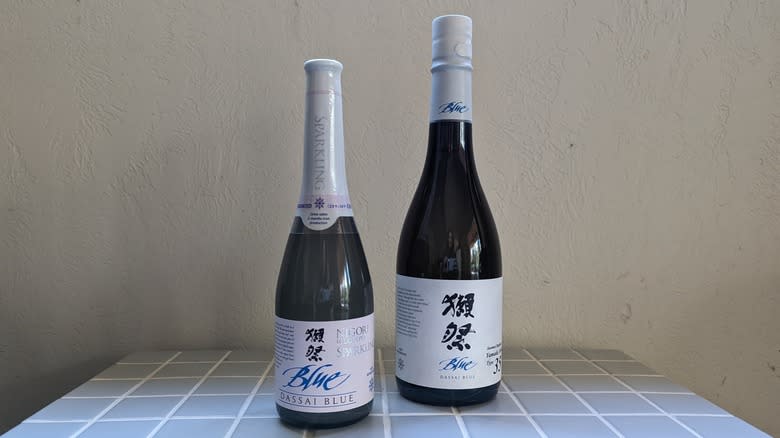
Of all the sake I tasted from Dassai Blue, I found Type 35 to be the most balanced. It has more of a delicate body and finish than the Nigori Sparkling because it's not a cloudy sake and in part because the rice has been polished down to only 35% of the original grain. This hones in on some of the more delicate aromas and flavors, like sweetpea and white peach, highlighting them in a delicate way.
Compared to the Nigori Sparkling, Type 35 is much lighter, appearing nearly clear with only a faint golden hue. It also has significantly less obvious sweet notes, only giving a hint of maple syrup alongside the ripe papaya, orchard pear, and yogurt. It's more delicate while still having obvious fruit notes. While both the Nigori Sparkling and Type 35 are delicious, they really have different personalities and suit different occasions. I would pair the Type 35 with sashimi, fennel apple salad, or a herby chickpea concoction, while the Nigori Sparklings' larger personality and inherent sweet fruit profile are a better fit for peaches and cream and other foods with fruit-forward notes or a lactic, creamy texture.
Dassai Blue Nigori Sparkling Sake Vs. Dassai Blue Type 23
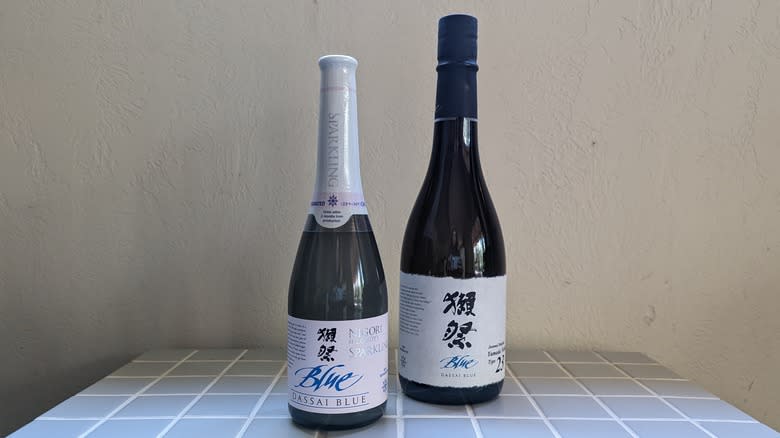
Dassai Blues' Type 23 is the brand's premium Junmai Daigingo sake, with the rice being polished down to only 23%. This means it is also the cleanest, smoothest, most delicate sake in the line-up. Floral aromatics of cherry blossom and faint honeysuckle are present but subtle. It's a completely different mouthfeel and profile from the Nigori Sparkling, with a much cleaner profile, brighter finish, and more acid overall.
Compared to the Nigori Sparkling, Type 23 has more notes of green fruit, like Asian pear, and even a bit of balsa wood. With only the essence of a drizzle of honey, it tastes significantly less sweet than sparkling nama sake. While both sakes could be paired with fruit and cheese, it's best to match each with similarly balanced items. For example, a burrata drizzled in piquant olive oil with chive blossoms and fresh peas would suit the Type 23 well, while a slice of manchego and pear salad is a better match for the Nigori Sparkling sake.
Is Dassai Blue Nigori Sparkling Sake Worth It?
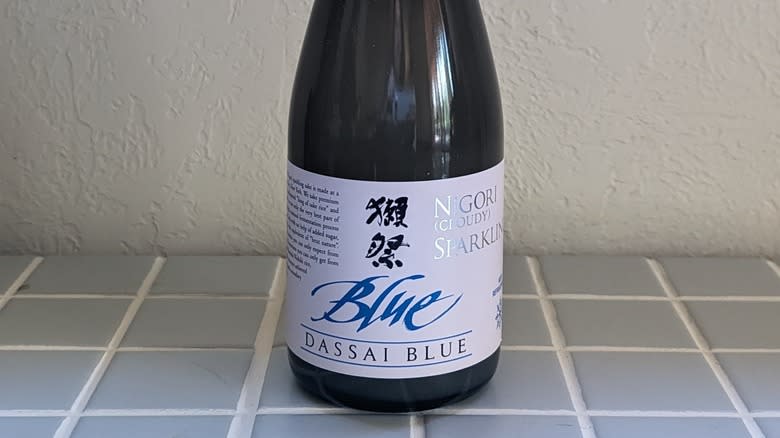
Overall, Dassai Blue Nigori Sparkling sake is a lively nigori sake that balances floral aromatics with crisp green orchard fruits and yellow tropical fruit flesh. With a wide range of flavors, a rich mouthfeel, and refreshing, tangy bubbles, the sake has a broad personality that suits a wide range of palates. It's not overly complicated but still has refined characteristics that bring it into the next tier, especially for a domestically-brewed sake. When served cold, it is truly a delight to drink.
If you're one to be captivated by the story and sustainability behind your beverage of choice, this is also a bit of a unique find, as Dassai Blue integrates domestic ingredients with Japanese tradition in a really beautiful way. The Dassai Blue Nigori Sparkling is stylistically unique for a U.S.-brewed sake and is worth trying whether you are an amateur or a sake lover.
Read the original article on Tasting Table


